Trunk Mounted Battery Installation
A thread on Coral.net Mustang forums complained there were no standard battery relocation systems. While true, there are good reasons causing the lack of a standard system.
NHRA and IHRA Rules are major problems preventing a standard safe system:
I. IHRA and IHRA rules are contradictory, lack safety, and are not very clear. For example in a given speed and class car, NHRA rules require a rear switch with a battery relocation but do not require a cutoff switch with a front battery. Same car, same speed, exactly same crash risk, but a relocation apparently requires a way to kill the engine (although they are not clear about that) from the rear. This is completely illogical, unless the goal is to protect the battery line.
II. If the NHRA and IHRA goal is to protect the battery line to prevent fires, they created a situation that is UNsafe with the cut-off engine rule (if that is a rule). The reason it is unsafe is cutting off the engine requires an alternator lead all the way to the battery, so the switch breaks all running power. This leaves a continuously hot alternator lead running all the way to the front, unless the rear switch is a DPST switch and the alternator passes through a second pole.
The circuit below is safer for fires, but not for surges if cutoff switch opens. With a fuse link at battery and no cutoff switch, it can be as safe as OEM wiring.
Less wire fire hazard, but engine requires some sort of cutoff. Factory EFI Mustangs have automatic fuel cutoff switch.
The circuit below uses OEM fuses and protects the new long cable with a battery negative link. It is just as safe as OEM when the cable is routed properly, but has no cutoff switch.
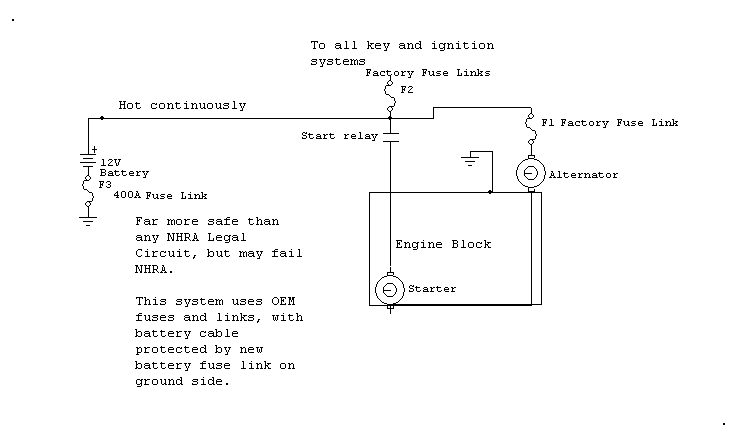 |
The circuit below never disables alternator feed. It is unsafe for fire, but safe for surges. It only breaks the hot continuous start if the switch is open, so it really isn't safe.
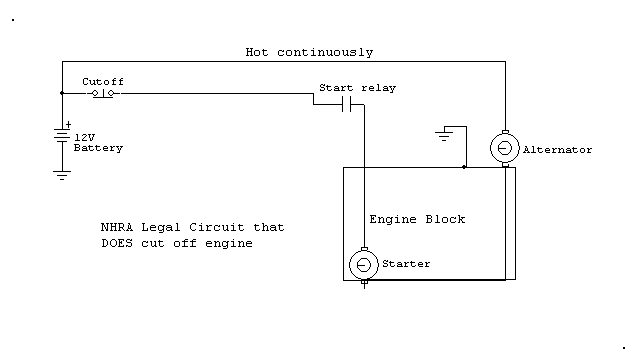 More wire fire hazard because alternator wire always connects to battery. NHRA does not require fuses or breakers. This creates an unsafe condition for racers. This circuit causes two problems. First, the alternator lead and alternator internals are always hot. Second, the alternator and battery cables are not protected. This is a fire hazard! It does, however, make NHRA tech happy (even if it makes the car unsafe).
|
The circuit below can break the hot continuous wires if F1 blows, and the switch is opened.
|
|
The circuit below cuts off all leads to front and prevents spikes at the battery or on the start relay line from hot cutoff or bad switch connections.
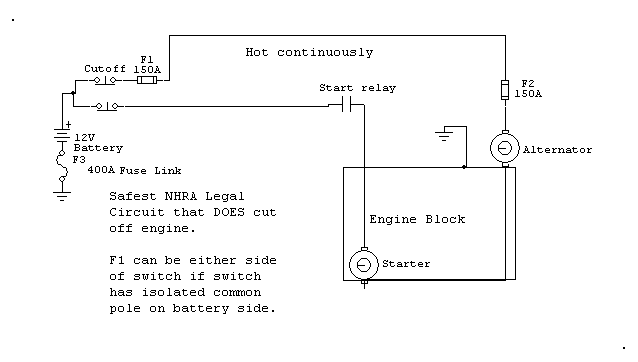 Note dual
switch contacts Note dual
switch contacts |
The circuit below is safest for switch connection issues or crashes. It might fail NHRA because of start relay line, although it should pass **if** they know what they are doing. It is the safest system. I ran a similar system for years in an 8 second car (less alternator side), and only one tech inspector ever questioned it.
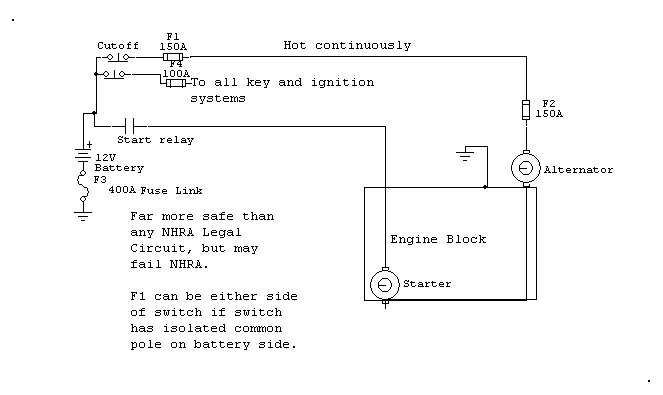 |
The system below should pass NHRA if they don't understand the circuit above. It is less safe in a crash, but it satisfies their requirements of disconnecting through a switch if they don't like the start relay relocation. The 12V feed for car electronics can be moved to the start relay battery side terminal if the start relay is in front.
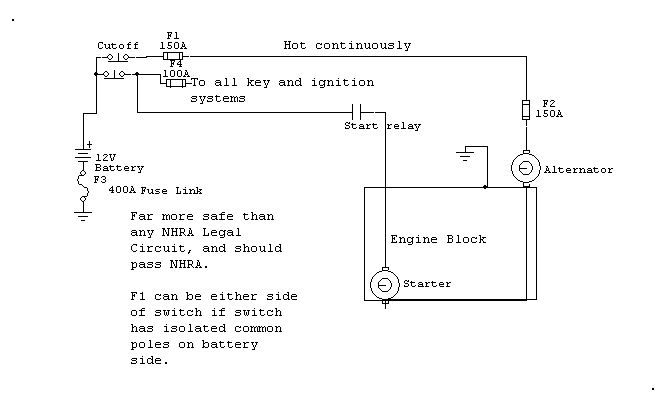 |
All systems are slightly different, but here are general rules:
1.) Route the wires safely. Do not run any electrical wires where they can chaff or rub against things, be easily cut or damaged, and against fuel or brake lines.
2.) Never run high current leads through flammable materials or inside vehicle passenger compartments. The exception to this is if the cable meets proper safety specifications for flammability, thermal, and insulation ruggedness. The cable should generally be protected or armored inside the car, or where it might contact damaged in an accident.
3.) Always use the appropriate fuses, fuse links, or circuit breakers on SOURCE ends of wires as close to the source as possible. The proper size protection is always based on maximum current draw in normal conditions, assuming the wire is properly sized. There are two sources. The alternator is a source, the battery is a source.
4.) DO NOT size protection based on wire current rating for the wire type and gauge, unless wire gauge is running right at load current maximum (which is unsafe anyway).
5.) Fuse ratings are not hard limits. A typical 100-ampere fuse takes up to 120 seconds to blow at 200% overload, but can also fatigue or blow at less than actual fuse rating if in a hot environment, if the holder contacts are loose or dirty, or if has been subject to short overloads.
6.) A fuse, switch, or breaker should never be placed so the battery can be removed accidentally while the alternator is running. This, like any loss of battery connection on a running engine, can spike the electrical system and ruin your expensive electronics.
7.) Fuses and breakers can not be paralleled to reliably increase rating. If you parallel connect a fuse or breaker, it does NOT necessarily double the rating. This is because a fuse or breaker will not have the same exact resistance of another identical part, so current will probably not divide equally between them. This isn't harmful, it just means the system might be fused lighter than you assume it is fused.
8.) Fuse links are most reliable to prevent false failures if very high current, but are only for fire protection. Bolted fuses, like marine fuses, are most reliable high current at lower currents.
9.) For a ground wire longer than ~4 feet, the chassis of a vehicle generally has much less resistance than any size copper you can run. The only possible problem is getting a solid connection to the chassis.
10.) The block of a vehicle has far less resistance than any copper you can run.
11.) In order of engine ground effectiveness, it is block, heads, bell housing, and timing cover. All are OK. The intake is a bad ground point.
12.) The frames and sub frames are good ground points, if properly attached. The firewall is a good ground point, as is any body welded panel, if a good connection is made.
Trunk Mounted Battery Installation
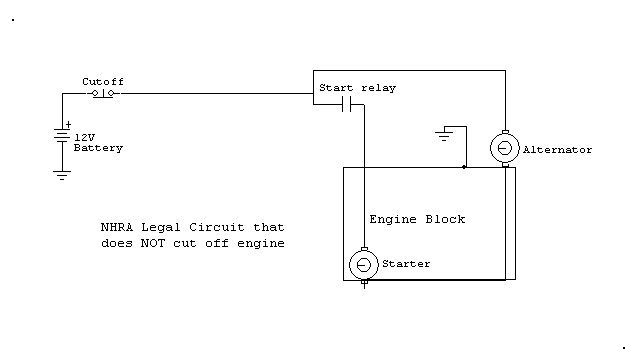
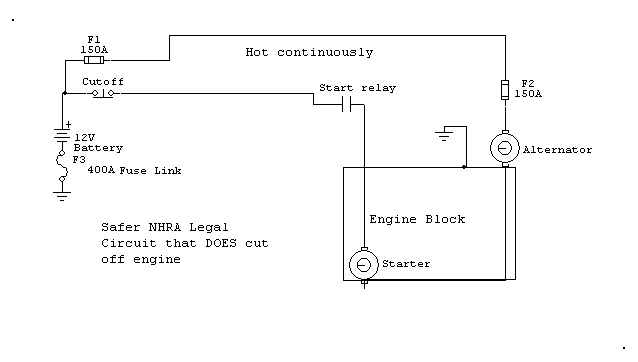 Note two fuse
locations and fuse link.
Note two fuse
locations and fuse link.